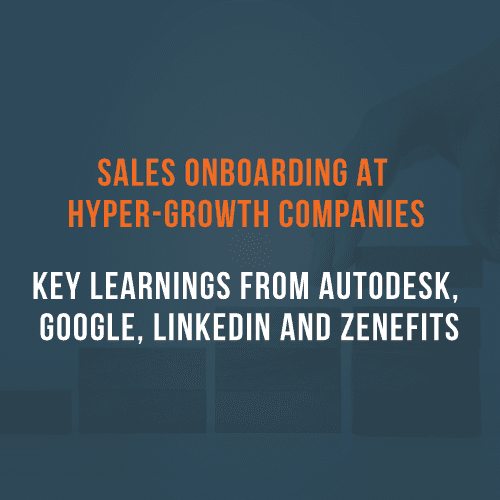 Last week I attended the
Last week I attended the
Onboarding 2025
event in San Francisco at the beautiful
Autodesk Gallery
where Sales Enablement leaders from some of the top companies in Silicon Valley shared their sales onboarding plans and their experiences in what proved to be an extremely productive discussion.
Here are part 1 of the key takeaways from each session. You can find part 2 here.
Autodesk: Julie Sokley, VP Global Sales Operations
Julie gave a great overview of the challenges she faced when taking over Sales Ops at Autodesk. She had to enable a team of over 250 sales reps globally. Her approach followed three key elements: Processes, productivity, and people.
Focusing on the “people” element, she established a sales methodology, built out a hub-based selling approach and created a sales onboarding program.
Key Learnings:
- Think about structuring your sales onboarding into three phases:
- Before you join
- While you are here
- After onboarding
- Pre-work is important. Autodesk gives new sales hires 50 hours of pre-work.
- Autodesk transitioned from product-based selling to pain-point selling, which contributed to their growth. How are your teams approaching selling situations?
- Don’t send sales reps data, send them stories. This was a critical takeaway as we sometimes get so focused on data that we forget that you need compelling stories to change sales behaviors.
- Focus on the “why” of training, not the “what”. This will help you get executive buy-in and involvement in sales onboarding.
Google: Jen Bradburn, Sales Training and Development Lead
For the past ten years, Jen has led sales training programs at Google for different groups. During her presentation, she explained how she has changed the sales onboarding for new Google sales reps from a pure online and self-serve experience to interactive and case-study based training. The use of real scenarios during the onboarding program has helped prepare and give reps the confidence they need to work on deals as soon as their onboarding is over.
Key Learnings:
- Use real sales scenarios and make them interactive case studies for the reps, so they can apply the theory into real sales situations.
- By overloading the reps with the information they would face in a live selling scenario you can simulate what they would encounter in real life and assess their selling skills.
- Reps face many surprises in real life, so how can you add those dynamics during onboarding? Google reorganizes the teams going through onboarding so the reps have to scramble and form new teams as they work on case studies which mimic challenges they will have in real situations.
- Google has designed their sales onboarding with a mix of 50/50 instruction and practice. Find the right balance for your organization.
LinkedIn: Amy Borsetti, Global Director of Sales Effectiveness; Naomi Davidson, Sr. Operations Mgr of Sales Effectiveness; Thomas Igeme, Sales Effectiveness Strategy & Innovations Lead; Jade Bonacolta, Strategy, Innovation & Analytics Associate
Four people from LinkedIn led an incredibly interesting session focusing on data-driven sales coaching, which aims to address the most important question in everyone’s mind:
Are sales reps truly ramping effectively?
Amy had a great slide that said:
“Successful onboarding calls for mutual accountability across sales effectiveness and sales managers”
She talked about the importance of involving sales managers during onboarding and beyond. The new sales onboarding at LinkedIn also has a different approach, focusing on five phases:
Phase 1: Structured pre-work
Phase 2: Classroom-based simulation
Phase 3: Role-based sales clinics and leader-led series
Phase 4: Sales coaching
Phase 5: Success program for under-performers
They also have an interesting approach in which they talk about “Learning Quota” (Phase 1 and 2), “Behavioral Quota” (Phase 3) and “Sales Quota” (Phase 4 and 5).
But the most impactful change the team at LinkedIn did was related to sales coaching. They deployed a “Coaching for Gold” program to train sales managers on how to coach. It explained why to coach, how to coach, and who to coach. They also taught managers the difference between teaching, coaching, and mentoring and implemented a tracking tool to help them record and track their coaching sessions.
Key Learnings:
- Approach your onboarding program with the different types of quotes in mind and create KPIs for each phase. You want to identify reps that are not going to be a good fit early on.
- Focus on your B players. LinkedIn saw the best results in terms of lift in performance from their B players.
- Managers should prioritize coaching efforts and identify the reps who need the most. In fact for reps that received 3 or more coaching sessions on the same competency the lift in quota attainment was up to 14% more than before. That’s a huge impact on revenue.
- Identify what are the core competencies every rep needs to master and document it and measure how each one impacts results.
- Build a culture of coaching at your company starting with senior level executive sponsorship so that it becomes a habit for all sales managers.
Zenefits: Elizabeth Pierce, Director of Training and Enablement
Elizabeth walked us through the sales onboarding program at Zenefits and the technology they rely on to get reps up to speed. From pitching, flashcards, quizzes, and more, the sales reps are fully supported by a variety of technology tools that help them ramp up faster.
At Zenefits she implemented a 70:20:10 learning model that splits the time reps spent on different learning activities:
70%: Experience (immersion, experiential learning, learn and develop through experience)
20: Exposure (social learning, learning, and development through others, feedback, and coaching)
10%: Education (formal learning, learning and development through structured courses and programs, in-house and outsourced training and e-learning)
Key Learnings:
- Leverage the technology your reps are comfortable with. At Zenefits most of the new hires are millennials and use SnapChat, so they created specific training that leverages the platform the team is comfortable with. It also has the added benefit of giving them 24 hours to see and act on a video or other training component. Very creative!
- Link sales reward with certification. By linking opportunities in SFDC with sales certification, they ensure reps can only see sales opportunities if they keep their sales certification up to date (as soon as their certification expires, they lose visibility into new opportunities).
- Ramp time needs to match the company’s stage. Startups can’t wait 9 months for a rep to be fully ramped. Your ramp time needs to acknowledge your company’s stage in growth and lifecycle.
- Use ongoing assessments in the form of short quizzes to keep reps on top of their game and share the data with the sales manager so they have full visibility.



 By Rahul Mathew
By Rahul Mathew

